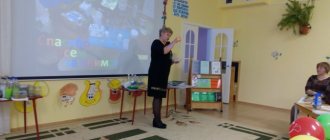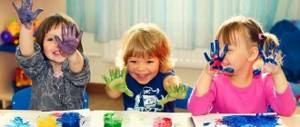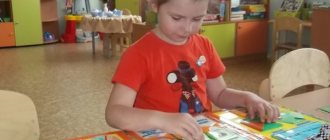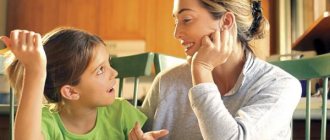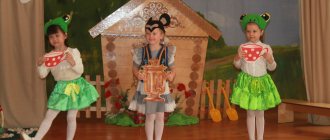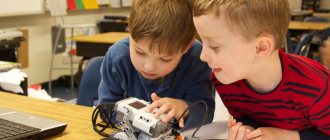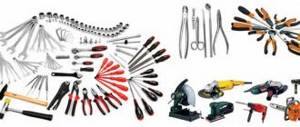Features of the development of constructive activity of preschool children
Children, like adults, before starting to create a design, formulate their idea for themselves (and in younger preschool age, for those around them). As soon as a child has an idea, he already looks around to see what available tools or details will help him realize it.
The original plan is not always kept in the focus of the “designer’s” attention. Interest may dry up or plans may change: “Let it not be a car, but a rocket,” “I don’t want to build, I’ll draw!”
This is one of the features of the constructive activity of a preschooler - not every idea finds its implementation. Building takes effort, and the baby needs encouragement and support to see it through.
The development of constructive activity in preschool age occurs in two directions:
- construction of buildings for the game
- creation of image models
In the second case, constructive model activity takes place. An example of such design is the assembly of models from ready-made sets of wooden or plastic parts.
Buildings for the game is a responsible matter. Children design them to perform desired functions. If this is a bridge, then it must be stable so that cars can be rolled along it. If it is a “bus”, then it should have enough space for all players and you need to arrange a separate cabin for the driver.
Types of constructive activities for preschoolers
In design, two types can be distinguished, available at preschool age:
- technical
- artistic
Technical design is based on the real characteristics of objects, taking into account the shape and structure. The child builds a house from cubes and bricks and at the same time makes sure to highlight the doorway and designate the window.
The technical type includes the assembly of various models, where the parts are fastened together using grooves or bolts. In this form, a creative approach is used, but taking into account real relationships.
As for artistic design, it is more important for the author to convey not the ratio of quantities or the structural content of the object, but its character and emotional content. For example, the boys decided to create the image of a gorynych snake by adapting a children's table as a body, laying out a tail from cubes, and placing floor lamps instead of heads. In this case, the constructed image is designed to reflect the essence of a frightening fairy-tale character.
Forms of design in preschool age
Depending on what degree of accuracy or independence a preschooler needs to show in making his model, developmental psychology distinguishes four forms of constructive activity:
- according to the model
- by design
- according to the conditions
- frame construction
With a sample, kids begin their first steps in this type of activity. Parents, playing with their children, build either turrets or houses, and encourage them: “Now make a tower like this.” The child watches how the adult assembles the structure, sees the completed object and strives to repeat the same actions.
In early preschool age, such models are the simplest. But designing according to a model is gradually gaining complexity. Moreover, in some cases it can be the most difficult form of creating a structure. For example, by providing an older preschooler with an assembled model of an airplane and a set of parts, you can set the task of assembling the same toy. The child has a difficult job ahead of him. You need to figure out what parts are used in the model, how they are fastened together, and in what order to assemble, and then begin to carefully complete the task.
Let's start implementing the plan
The design according to plan also differs with different levels of complexity . That is, the child does not need to maintain the accuracy of the sample; he can create everything at his own discretion. On the one hand, this simplifies the task, but on the other, it complicates it. You need to come up with everything yourself, from the idea and selection of materials, what to build from, to the final appearance of the building.
Older preschoolers have such global plans that they cannot do without preliminary schematic planning. Have you noticed how one child draws in the sand and explains to another where and what to place in the future model?
Design according to conditions can be compared to a plan, but someone else’s. When an adult sets conditions for a preschooler to build a house for dolls from Lego parts, but so that each doll has its own room and a common room for all, this is the adult’s intention. The child will have to pay close attention to the conditions and figure out how to complete this task.
The conditions set for the child often make it easier for him to start designing. Many children get lost at the stage of searching for an idea of what to build or what model to create.
Frame construction is a special approach to completing a task that guides the child’s mental activity. This form of activity focuses on identifying the main elements of the future model and frame assembly. Once the base is ready, you can begin filling with smaller parts.
The use of a frame in design is an almost adult approach to creating a model, requiring analytical and synthetic mental activity and developing spatial thinking.
GCD summary. TOPIC: “FIXIK VISITING PRESCHOOL CHILDREN.” (construction from Lego)
Educational activities of an artistic and aesthetic orientation made from Lego develop technical thinking in preschoolers, and joint work with parents contributes to the development of social and communicative development. Topic: “Fixie visiting preschoolers.”
Age group: senior.
Goal: development of technical thinking in children.
Integration of educational areas: “Artistic and aesthetic development”, “Socio-communicative development”, “Cognitive development”, “ Speech development”, “Physical development”.
Tasks:
- Form the development of prerequisites for creating a transport model according to the scheme, the perception of music. (Artistic and aesthetic development).
- Develop cognitive activity through constructive activities with the help of new generation construction sets. ("Cognitive Development")
- Enrich and activate your vocabulary. Improve the dialogical form of speech, the ability to formulate your point of view (Speech development).
- Form the development of prerequisites for creating a transport model according to the scheme, the perception of music. (Artistic and aesthetic development).
- Develop the ability to work in pairs with adults, distribute responsibilities without interfering with each other. (Socio-communicative development).
- Develop children's motor activity and coordination of movements (Physical development).
Preliminary work: Observation of transport during a walk, transport on which food is brought to kindergarten, conversations, games with cars, and construction sets.
Methods and techniques:
- practical: Lego construction sets, finger gymnastics;
- visual: diagrams, balloon, Fixik toy, box;
- verbal: direct questions, leading questions, explanations, riddles, reading a poem;
- playroom: Lego construction sets,
Materials and equipment: a balloon, a Fixik toy, a box with a Lego constructor, riddles about transport, a player, a flash drive.
| Children's activities | Forms and methods of organizing joint activities |
| Cognitive and research | Naming helper objects. |
| Communicative | Conversation, guessing riddles, situational conversation, questions |
| Perception (fiction and folklore) | Telling riddles, reading a poem |
| Motor | Finger gymnastics, |
| Musical | The sound of musical works |
Logic of educational activities
| № | Activities of the teacher | Activities of pupils and parents | Expected results |
| 1. | Organizing time. - Everyone gathered together in a circle. You are my friend and I am your friend. Let's hold hands tightly and smile at each other. - Dear, good, how are you doing? Today design has come to visit you. (knock on the door) | Children and parents stand in a circle, hold hands, smile, and answer the question. | A positive emotional mood for educational activities has been created. Friendly relationships between peers and parents. The ability to perform movements according to the text is consolidated. |
| - Is someone knocking? May I take a look? (goes to the door, brings in a balloon with Fixie). | They look at the door with interest, wait, smile, rejoice at Fixik’s appearance. | Voluntary attention is attracted. | |
| 2. | "The Appearance of Fixik" (teacher on behalf of Fixik) – Hello dear parents and you children: girls and boys! Please name the topic of the week? What types of products are there? Where can you buy groceries? What happens when stores run out of food? (praises for answers) | Children and parents answer questions, name products and transport. | Developed dialogical communication, the ability to answer in full sentences. Knowledge of product classification has been generated. |
| 3. | "Riddles about transport" – I came for a reason. My fairytale friends have run out of food in their stores and have nothing to bring. I don’t even know what to do? - Well done, but first let’s remember what transport has. Puzzles
| They listen attentively and offer to arrange transport. | Developed attention and thinking. |
| 4. | "Design department" – Transport is made by design engineers. Do you want to become one? They circled left and right and into the engineers designers have turned. (hands out Lego construction sets, turns on music). | They listen, answer the question, follow the text, choose a pair, sit at the tables, work according to the scheme together with parents. | Formed: constructive thinking, working according to a scheme, social skills of mutual assistance. Fine motor skills are affected. |
| 5. | Reflection. – So we returned from the design bureau. – I want to ask, what kind of transport did you get? Please tell me, who will you deliver the products to in your transport? Reading a poem. "Lego" is a smart game, enticing, cunning. It's fun to play with her. Build, compose, search! It’s also interesting for adults: it’s useful to play with Lego. Thank you very much. | They answer questions, name the transport and the fairy-tale character for whom the transport was made, and listen to the poem. | Dialogue speech has been developed, the ability to answer questions in complete sentences. Emotional responsiveness to the outcome of the lesson is developed. |
Stages of constructive activity
Whatever object a preschooler plans to build, certain knowledge and skills are needed. Even when building the most ordinary tower from cubes and cylinders, you need to take care of its stability. And for this, it is important to place the most voluminous part at the base. Therefore, constructive activity occurs in several stages:
- Examination of a possible structural material: shape, size, characteristic features, what functions it can perform (a cube is stable, all sides are equal, can serve as a base; a cone is suitable for completing a building, can be used as a part of a fence, etc.)
- Determining the main components of the object, designating the shape and spatial dimensions (We are creating a car for the game: only the driver will sit in the cab, and in the back there will be two people at the side on the right and left).
- Constructive actions: sequential construction of the model (laying out a series of cubes as a body outline, assembling a wall from LEGO parts, connecting plates for a bridge, etc.)
- Holistic perception of the result obtained and correlation with the initial plan.
- Corrections and additions to the design if a discrepancy with the idea is found.
The listed stages are observed both in the creation of simple buildings by children and in the construction of complex models by older preschoolers. Already at 4 years old, a child, surprising his parents, is able to conduct a primary analysis that the bridge consists of a brick, another brick and a plate.
Five-year-old children are attentive to the shape and size of parts. They acquire analytical skills and will not only tell you what kind of structure it is and what parts it consists of, but can also suggest improvements to the building.
At 6-7 years old, children fairly fully analyze the structure of the model, identify the main and auxiliary parts, take into account the special qualities of the parts (stability, length, flexibility, etc.), and plan the sequence of creating the structure.
Monitoring Constructive and modeling activities
Navigation:Home Random page Feedback TOP Interesting to know Favorites
Top:
Theoretical significance of the work: A description of the theoretical significance (value) of the research results should be present in the introduction...
Assessing the effectiveness of communication policy tools: External communications - the exchange of information between an organization and its external environment...
Organization of surface water flow: The largest amount of moisture on the globe evaporates from the surface of the seas and oceans...
Interesting:
How we speak and how we listen: communication can be compared to a huge umbrella under which everything is hidden...
National wealth of the country and its components: to assess the elements of national wealth...
What to do if you have leukemia: First of all, you need to find out if you are suffering from any mental illness...
Disciplines:
Automation Anthropology Archeology Architecture Audit Biology Accounting Military science Genetics Geography Geology Demography Journalism Zoology Foreign languages Computer science Art History Cinematography Computerization Shipbuilding Cooking Culture Lexicology Linguistics Literature Logic Marketing Mathematics Mechanical engineering Medicine Management Metallurgy Metrology Mechanics Musicology Science science Education Labor protection Pedagogy Political science Legal relations Entrepreneurship Instrument making Programming Production Industry Psychology Radio communications Religion Rhetoric Sociology Sports Standardization Statistics Construction Theology Technologies Trade Transport Pharmacology Physics Physiology Philosophy Finance Chemistry Economy Drawing Ecology Economics Electronics Energy Jurisprudence
| ⇐ PreviousPage 3 of 3 | |||||||||||||
| Group average | 2016-2017 academic year | ||||||||||||
| Educators | |||||||||||||
| Indicators | |||||||||||||
| Uses building parts, taking into account their structural properties | |||||||||||||
| Transforms buildings by building on them in accordance with the teacher’s instructions | |||||||||||||
| Transforms buildings taking into account their functional purpose | |||||||||||||
| Creates buildings with a familiar theme according to the conditions set by an adult | |||||||||||||
| Distinguishes from what parts a group of objects is made up, names their characteristic features (color, size, purpose) | |||||||||||||
| Able to make simple generalizations, establish simple connections between objects and phenomena | |||||||||||||
Criteria: not formed (N), is in the process of formation (F), formed (C)
Diagnostic task: “House for fairy-tale heroes”
Material: building set, toys
Assignment: The child is asked to build houses for fairy-tale characters: one house for the bun, another house for the bear cub (he lives on the first floor) and for the Chanterelle (she lives on the second floor of this house).
Criteria for evaluation:
Formed (C) –
The child completed the task independently.
Is in the stage of formation (F) –
The child completes the task with the help of an adult.
NOT formed (N) –
the child fails to complete the task.
Diagnostic task: “Build a building according to the diagram”
Material: construction diagram, designer.
Questions: What detail lies at the base of the building?
What part is placed on the base?
Task: The child is asked to look at the construction diagram and complete the construction according to the diagram.
Criteria for evaluation:
Formed (C) –
The child completed the task independently.
Is in the stage of formation (F) –
The child completed the task with the help of an adult.
Not formed (N) –
the child failed the task.
Diagnostic task: “Building a bridge for cars”
Material: construction set, toys, cars.
Questions: highlight the main parts of the object, show and name each part of the bridge, determine the characteristics and purpose.
Assignment: the child is asked to build a bridge over which a car could drive in two directions.
Formed (C) –
The child completed the task independently.
Is in the stage of formation (F) –
The child completed the task with the help of an adult.
Not formed (N) – child
failed the task.
Diagnostic task: “House for fairy-tale heroes”
Material: building set, toys
Assignment: The child is asked to build houses for fairy-tale characters: one house for the bun, another house for the bear cub (he lives on the first floor) and for the Chanterelle (she lives on the second floor of this house).
Criteria for evaluation:
Formed (C) –
The child completed the task independently.
Is in the stage of formation (F) –
The child completes the task with the help of an adult.
NOT formed (N) –
the child fails to complete the task.
Diagnostic task: “Build a building according to the diagram”
Material: construction diagram, designer.
Questions: What detail lies at the base of the building?
What part is placed on the base?
Task: The child is asked to look at the construction diagram and complete the construction according to the diagram.
Criteria for evaluation:
Formed (C) –
The child completed the task independently.
Is in the stage of formation (F) –
The child completed the task with the help of an adult.
Not formed (N) –
the child failed the task.
Diagnostic task: “Building a bridge for cars”
Material: construction set, toys, cars.
Questions: highlight the main parts of the object, show and name each part of the bridge, determine the characteristics and purpose.
Assignment: the child is asked to build a bridge over which a car could drive in two directions.
Formed (C) –
The child completed the task independently.
Is in the stage of formation (F) –
The child completed the task with the help of an adult.
Not formed (N) – child
failed the task.
Didactic task: “Fold a sheet of paper in different ways”
Material: two squares, two rectangles.
Task: the child is asked to fold a sheet of paper (diagonally, in half, lengthwise, crosswise).
Formed (C) –
The child completed the task independently.
Is in the stage of formation (F) –
the child completed the task with the help of an adult
Not formed (N) –
the child failed the task.
⇐ Previous3
Papillary patterns of the fingers are a marker of athletic ability: dermatoglyphic signs are formed at 3-5 months of pregnancy and do not change throughout life...
Organization of surface water flow: The largest amount of moisture on the globe evaporates from the surface of the seas and oceans (88‰)…
Transverse profiles of embankments and coastal strips: In urban areas, bank protection is designed taking into account technical and economic requirements, but special importance is given to aesthetic...
Single-post wooden support and methods for strengthening corner supports: Overhead line supports are structures designed to support wires at the required height above the ground, water...
Construction as a means of developing creative abilities
It is obvious that constructive activity contributes to the development of mental operations, forcing the preschooler to analyze, compare, and synthesize disparate parts into a whole. This type of activity is no less useful for developing a child’s creative abilities.
In order to create a model, first of all, you need to imagine it in your imagination. At first it will be a rather sketchy image. As it is implemented, it will be supplemented with details.
The older the preschooler, the more innovations appear in the design. It is no longer enough to just build a bridge. Older children will definitely clarify its purpose - automobile, railway, adjustable... At the same time, they will add some kind of identifying symbolic signs.
Selecting elements for a design, improving components, finding new methods of construction, discovering new properties of previously used materials, creating new combinations is a wide field for creative activity and the development of a preschooler’s creative abilities.
Materials for modeling. Paper
Constructive activities in the senior subgroup of kindergarten are carried out mainly from paper, cardboard boxes, thread spools and other materials. This type of activity requires more energy than regular games.
Children are given paper and cardboard squares, rectangles, circles, etc. The preliminary stage before making a toy is preparing a pattern, working out details and decorations. It is necessary to thoroughly check all the cuts and only then begin making the toy. The child must be able to measure, use scissors and needles. This is a much more complex process than the usual constructive activity in the preparatory group, which consists of creating toys from ready-made shapes. Various parts of boxes, reels and other materials used in this case are the so-called semi-finished products. If you teach children to see and form a single whole from various parts, then in this way you will develop tactical and strategic thinking in the child, and besides, he will learn to create interesting toys from scrap materials.
If a child uses paper in construction, he becomes familiar with such concepts as angle, side, plane. Preschoolers learn to bend, cut, bend, deform paper and thereby create completely new images from it. By modeling various geometric shapes and figures of animals and people, preschoolers learn to create compositions and various combinations of crafts. Preschoolers acquire the skill of making various crafts from matchboxes using various combinations and connections. With the help of these processes, children acquire completely new skills and abilities.
Games with magnets
Relevance of the project:
I like to conduct all sorts of experiments, research, make different buildings out of construction sets, and invent games. Magnets have fascinated me for a long time. If I make games with magnets, I will become smarter, I will know more about the laws of inanimate nature and technology. I can play and surprise my friends.
Hypothesis:
Studying the properties of magnets and creating magnetic games based on them will expand my knowledge, improve coordination of movements, speech, and help me find even more friends to play with.
Goal : Create your own games with magnets.
Tasks:
- Explore the properties of magnets.
- Create your own games with magnets:
– tabletop puppet theater “Kolobok”,
– volumetric “Cat and Mouse” labyrinth,
– magnetic constructor.
- Introduce the children in your group to magnetic games and crafts.
Methods:
- Studying the properties of magnets through the Internet and the encyclopedia.
- Experiments with magnets.
- Independent creative work on creating magnetic games.
- Games with peers.
Experiments and experiments with magnets.
Experiment 1. What materials does a magnet attract?
Materials and equipment: magnet and objects made from different materials.
Progress of the experiment:
We took objects from different materials: paper, a wooden toothpick, an iron clip, an aluminum washer, a shiny plastic tip, a brass part, a plastic cube. A magnet was brought to each object in turn. Have you found out which of these materials will be attracted?
Only the iron paper clip was attracted to the magnet. The magnet did not attract any other materials, even those similar to iron: an aluminum washer, a brass part, a shiny tip.
Conclusion: A magnet attracts only iron.
Items made from different materials.
The magnet attracted only iron objects: a paper clip, a screw, a ball.
Copper wire, aluminum washer, brass part, shiny tip - the magnet was not attracted. They are not iron, although they look like iron.
Experiment 2. Magnets act at a distance.
Materials and equipment: 3 magnets, iron clips, pen, sheet of paper.
Progress of the experiment:
We drew a “Start” line on paper and placed a paperclip on it. Then they began to slowly move the magnet towards it. At some distance, the paperclip suddenly “jumped” and stuck to the magnet. We marked this distance. Then we carried out the same experiment with two other magnets. Each time, the distance from which the paperclip “jumped” and became magnetized was noted.
We saw that one of the magnets is stronger. He magnetized the paperclip from a further distance. And the other two magnets are weaker. They magnetized a paper clip at close range.
Conclusion: There is something around a magnet that can act on objects at a distance. This is a “magnetic field”.
| This is the weakest magnet. He magnetized the paperclip when he was very close to her. | This magnet is stronger. The paperclip itself “jumped” towards him at a distance. |
This magnet is the strongest. He magnetized the paper clip to himself from the greatest distance. It has the strongest magnetic field.
Games with magnets.
Magnetic tabletop puppet theater "Kolobok".
In a magnetic tabletop puppet theater, the figures move around the stage on their own, as if by magic. And the solution is simple: each doll has an iron clip in its stand. And the puppeteer moves a magnet under the stage, magnetizes these paper clips, forcing the figures to move in the desired direction.
Materials: cardboard box, colored paper, iron clips, magnet with a strong magnetic field.
Magnetic puppet theater "Kolobok".
Volumetric maze "Cat and Mouse".
The idea of the game is this: a labyrinth is a mouse’s house. Its role is played by an iron ball. By tilting the box, the ball can be rolled through the maze, setting the desired direction. The mouse “walks” around its house: it has a bedroom, a kitchen, and a storage room. He can go out for a walk, run through a tunnel. Or maybe just escape through a hole in the floor. It's game over. The main thing in the game: the mouse needs to be very careful of the cat - there is a strong magnet at the entrance to the house. The ball tries to “stick” to him. This means: “the cat caught the mouse” and this is also the end of the game.
Materials: Box, strong magnet, iron ball, scraps of building materials.
| Blanks for a three-dimensional labyrinth. | The labyrinth is ready. |
| The cat caught the mouse. | The mouse ran into a hole in the floor. |
Magnetic constructor.
The idea of the designer is this: to collect as many different magnets, tin cans, and iron parts as possible, suitable for creating a wide variety of robots. Magnets attached inside the cans will hold the iron parts on the outside of the can. Thanks to magnets, you can quickly assemble the robot. Be happy with the results of your work.
Materials: various magnets, iron parts: balls, mesh for washing dishes, lids for preservation, buttons, etc.
| The robot is a spider. | Game with a constructor. |
Conclusions:
After conducting experiments with magnets, I learned that magnets only attract iron objects. This happens because magnets have a magnetic field. Magnets are strong and weak.
Using the properties of magnets, I created my own games with magnets:
– tabletop puppet theater “Kolobok”,
– volumetric “Cat and Mouse” labyrinth,
– magnetic constructor.
Conclusion:
I enjoyed working on the project. I'll come up with some more games with magnets.
Literature:
- T. Pirozhenko “11 ideas for fun activities with children” https://www.tavika.ru
- Ideas with magnets for children. https://www.liveinternet.ru/users/krustal/post193630916/
- We play with magnets. https://letidor.livejournal.com/371380.html
